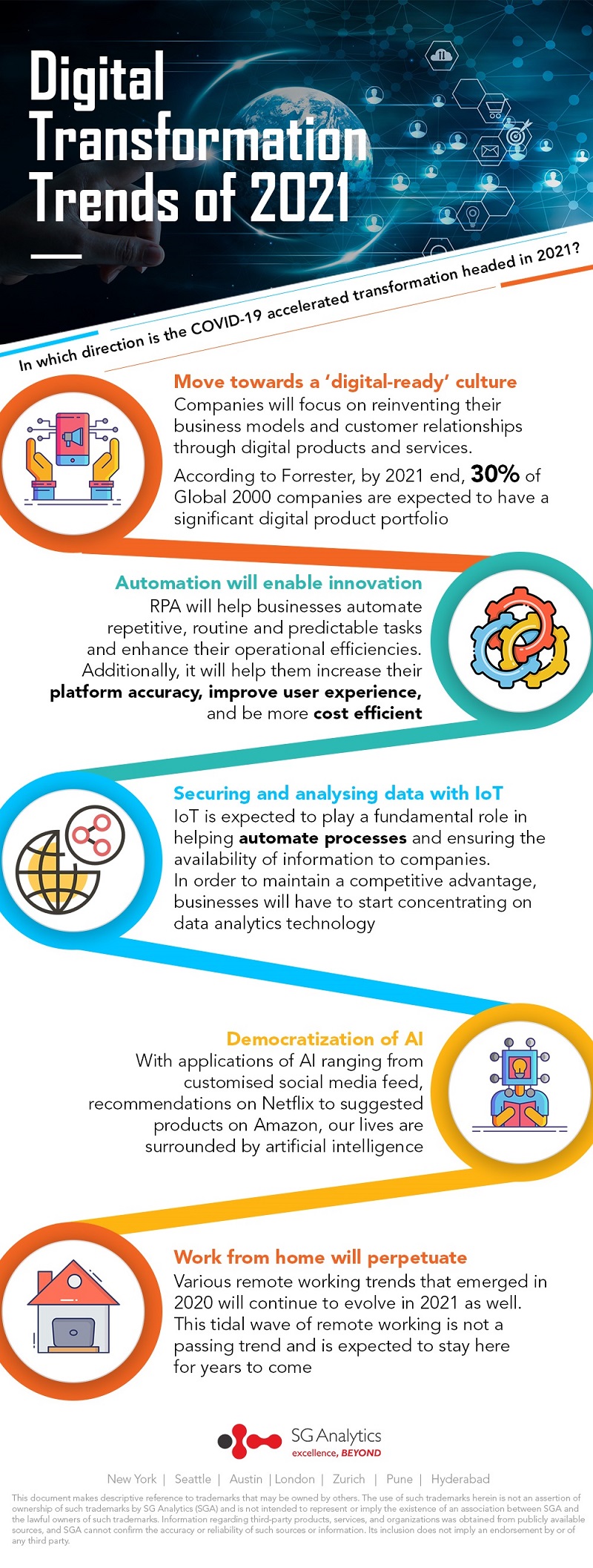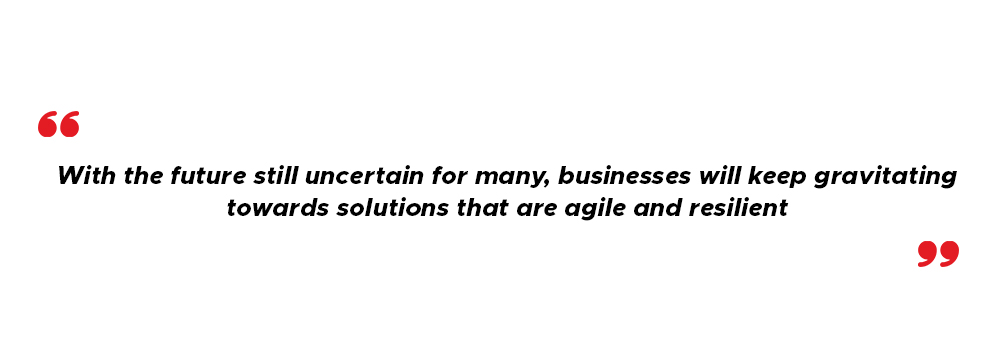The COVID-19 pandemic changed everything. No one knew where the year 2020 would lead us – the last nine months have witnessed more transformation in the digital space than the last decade. With the pandemic accelerating every transformation effort underway, many digital trends of 2020 such as 24/7 high-speed and secure connectivity benefitted from this shift.
The companies that were early adopters of agility, cloud, and strategy-driven partnerships were able to snap back with digital solutions. However, the ones which hadn’t scrambled and failed. According to Forrester, in 2019, 85% of companies considered digital as ‘nice to have’. In 2020, the coronavirus pandemic made everyone realize how critical digital is for a business’s success.
In a post-pandemic world, the focus will be on the accelerated adoption of top emerging technologies. Organizations across the world will also be concentrating their efforts on digital enablement, with a focus on channelizing their tech spending towards cloud infrastructure and workplace collaboration tools.
In which direction is the COVID-19 accelerated transformation headed in 2021?
The wave of digital transformation has hit almost every industry in the world. Companies are increasingly realizing the importance of embracing digital drivers such as automation, big data analytics, digital workforce, artificial intelligence, etc. As the world continues to become digital-dependent, the pressure on companies to stay competitive and relevant has increased tremendously. The role of IT is more critical than ever in today’s scenario. According to a report by MuleSoft, IT projects are expected to witness a growth of 40%.

Move towards a ‘digital-ready’ culture
Companies are experiencing coercion to digitalize their services rapidly so as to meet the increasing customer demands and explore new channels of revenue. The technology leaders are expediting their efforts to integrate digital transformation in their business – which is a major challenge. 89% of the leaders in the IT industry believe that ‘data silos’ create hindrance in realizing digital transformation initiatives.

Nowadays consumers expect consistent engagement with the brands across various communication channels. According to Deloitte, 75% of consumers expect steady interaction across all departments of an organization while 86% of the them prefer to have the ability to switch between channels while talking to a brand. As a result, organizations must invest in new digital methods in order to enhance the efficiency of customer service. According to KPMG, there will be 3X usage of channels such as community-based support website, messenger apps, social media, webchat, video calls and SMS chats in the post-Covid-19 era.
Companies will focus on reinventing their business models and customer relationships through digital products and services. According to Forrester, by 2021 end, 30% of Global 2000 companies are expected to have a significant digital product portfolio while 20% of them will focus on setting up digital divisions for launching disruptive products that will help them accelerate their transformation rate.
Automation will enable innovation
A research by MuleSoft reveals that 30% of IT decision makers believe that automation is a fundamental business initiative for accelerating digital transformation. McKinsey reports that 57% of the companies have started using automation in one or more business functions. Organizations around the globe have begun experimenting with or implementing automation. The coronavirus pandemic has significantly increased the investments in automation-driven solutions such as artificial intelligence (AI), machine learning (ML) and robotic process automation (RPA). In 2021, a higher number of organizations are expected to become platform-driven digital businesses, reinstating that the utilization of these technologies will continue to increase.

RPA will help them automate repetitive, routine and predictable tasks and enhance their operational efficiencies. Additionally, it will help them increase their platform accuracy, improve user experience, and be more cost-efficient. With the future still uncertain for many, businesses will keep gravitating towards solutions that are agile and resilient. In 2020, firms that adopted automation, IoT and cloud early on, fared the best.
Securing and analyzing data with IoT
The increase in online activities due to nationwide lockdowns and digital transformation that took place in 2020 have together contributed to spiking the number of data organizations have had to deal with. With the rollout of 5G expected to finally become a reality in 2021, the production of data that businesses are expected to contend with is also yet to skyrocket. In order to maintain a competitive advantage, businesses will have to start concentrating on data analytics technology which ensures secure data handling, analysis and further derivation of actionable insights from their unused operational data.
Suppose the COVID-19 restrictions get lifted by mid-2021, the most hard-hit industries such as the hospitality and travel industry may expect some growth again. However, firms that have the capabilities to offer customized experiences by using their data in a better way are likely to stand out amongst the customers.

In these scenarios, IoT is expected to play a fundamental role in helping automate processes and ensuring the availability of information to companies. With the proliferation in technology, IoT is increasingly getting intertwined with AI, grabbing a prime spot in an organization’s transformation programs and structures. Devices are becoming smarter and more intelligent.
Democratization of AI
The COVID-19 pandemic has accelerated the democratization of artificial intelligence and data. The government and companies were compelled to curate solutions at a fast pace so as to fence the spread of the virus. Naturally, they turned towards AI, ML, and data analytics to expedite the process. Even though the work has begun in 2020, it will continue its pursuit in 2021, expanding the horizon of opportunities such as finding solutions for global problems quickly, efficiently, and at scale.
While many still consider AI as a future trend, it is increasingly becoming a part of our everyday lives. With applications of AI ranging from customized social media feeds, recommendations on Netflix to suggested products on Amazon, our lives are surrounded by artificial intelligence. More and more companies are set to enjoy the benefits of AI with the increase in affordability of computing power, cloud services, software and frameworks.
Major chip makers in the world such as Intel, NVIDIA, Qualcomm, and AMD are innovating on semiconductors that power AI. They further deploy their chips (CPUs, GPUs, FPGAs, and ASICs) to the cloud. Organizations have the option to either directly gain access to this hardware and software or via third-party applications that help simplify and democratize AI.
Work from home will perpetuate
Companies across the world were compelled to make the shift to remote working overnight due to the strict lockdowns. Although the concept of work from home or remote working at scale was unacceptable to a majority of companies in the pre-COVID-19 era, the year 2020 left no other viable options for companies. While the pandemic continued to bring agony and despair for people across the world, it had become necessary for the companies to transition to remote working.
The coronavirus pandemic has indeed given work from home the “ultimate push” and redefined the way we work. Several big tech companies such as Google and Facebook have reported extending their work from home durations to parts of 2021. The transition to work from home was made possible by the rapid deployment of workplace collaboration tools such as Microsoft teams, Zoom, WebEx. The workplace collaboration software space has observed a massive rise in demand. In order to adjust to the ‘new normal’, various virtual collaboration tool providers have released additional features, helping businesses, in-house employees, remote workers, third-party vendors and independent contractors stay connected to each other.
Various remote working trends that emerged in 2020 will continue to evolve in 2021 as well. This tidal wave of remote working is not a passing trend and is expected to stay for years to come.
Conclusion
The COVID-19 pandemic has altered the trajectory and pace of digital transformation. The key takeaway from this year would be none other than – that, businesses need to go the digital way. Undoubtedly, the future of business will be driven by automation. Although the development of technology in 2021 will be a continuation from 2020, coronavirus will continue to have its impact on digital transformation. Major business and technological innovations are expected as we adjust more and more to the new normal in 2021.









